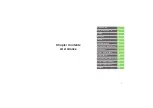
Impor
tant Safety Information
4A: Important Safety Information
149
Radio Frequency (RF) Energy
Understanding How Your Phone Operates
Your phone is basically a radio transmitter and receiver. When it’s
turned on, it receives and transmits radio frequency (RF) signals.
When you use your phone, the system handling your call
controls the power level. This power can range from 0.006 watt to
0.2 watt in digital mode.
Knowing Radio Frequency Safety
The design of your phone complies with updated NCRP
standards described below.
In 1991–92, the Institute of Electrical and Electronics Engineers
(IEEE) and the American National Standards Institute (ANSI)
joined in updating ANSI’s 1982 standard for safety levels with
respect to human exposure to RF signals. More than 120
scientists, engineers and physicians from universities,
government health agencies and industries developed this
updated standard after reviewing the available body of research.
In 1993, the Federal Communications Commission (FCC)
adopted this updated standard in a regulation. In August 1996,
the FCC adopted hybrid standard consisting of the existing
ANSI/IEEE standard and the guidelines published by the
National Council of Radiation Protection and Measurements
(NCRP).
Body-Worn Operation
To maintain compliance with FCC RF exposure guidelines, if you
wear a handset on your body, use the Sprint supplied or
approved carrying case, holster or other body-worn accessory. If
you do not use a body-worn accessory, ensure the antenna is at
least
25/32 inch (2 centimeters)
from your body when
transmitting. Use of non-Sprint-approved accessories may
violate FCC RF exposure guidelines.
For more information about RF exposure, visit the FCC website
at
www.fcc.gov
.
Specific Absorption Rates (SAR) for Wireless
Phones
The SAR is a value that corresponds to the relative amount of RF
energy absorbed in the head of a user of a wireless handset.
The SAR value of a phone is the result of an extensive testing,
measuring and calculation process. It does not represent how
much RF the phone emits. All phone models are tested at their
highest value in strict laboratory settings. But when in operation,
the SAR of a phone can be substantially less than the level
reported to the FCC. This is because of a variety of factors
including its proximity to a base station antenna, phone design
and other factors. What is important to remember is that each
phone meets strict federal guidelines. Variations in SARs do not
represent a variation in safety.
All phones must meet the federal standard, which incorporates
a substantial margin of safety. As stated above, variations in SAR
values between different model phones do not mean variations
LX370_Eng_090403:Sprint_UG_8a 09. 04. 04 오오 3:06 Page 149
Содержание LGLX370
Страница 14: ...viii LX370_Eng_090403 Sprint_UG_8a 09 04 04 오오 3 04 Page viii ...
Страница 15: ...Section 1 Getting Started LX370_Eng_090403 Sprint_UG_8a 09 04 04 오오 3 04 Page 1 ...
Страница 21: ...Section 2 Your Phone LX370_Eng_090403 Sprint_UG_8a 09 04 04 오오 3 04 Page 7 ...
Страница 119: ...Section 3 Sprint Service LX370_Eng_090403 Sprint_UG_8a 09 04 04 오오 3 05 Page 105 ...
Страница 157: ...Section 4 Safety and Warranty Information LX370_Eng_090403 Sprint_UG_8a 09 04 04 오오 3 06 Page 143 ...












































